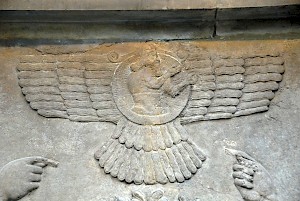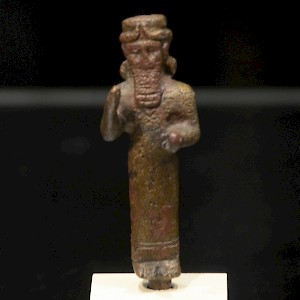Aššur (deity)

The main sanctuary of Aššur was the Bit Aššur in the city of Aššur, which is not among the oldest buildings in this town. It is therefore likely that the god originally was not a real deity, but the personification of the town, and started to attract cultic honors only later as if he were the deified city.
Aššur – city and deity at the same time – was invoked when the king was inaugurated. In the coronation hymn, it was stressed that Aššur was the real king and that the man who was about to be crowned was in fact not a king but a priest.
May your foot, placed in the temple of Aššur, and may your hands, stretched toward your god Aššur, be at ease! May your priesthood and that of your sons be at ease in the service of your god Aššur. Expand your land with your straight scepter. May Aššur grant you a commanding voice, obedience, agreement, justice, and peace.
It is interesting that, according to the tablets from Kültepe (the Assyrian trading post Kaneš in Central Anatolia), oaths were sworn by “the sword of Aššur” (patrum ša Aššur). It is possible, but not proven, that kings who had to swear allegiance to their Assyrian overlords, were requested to swear a similar oath.

Aššur received the attributes of the major gods of Sumer and Babylonia. It is certain that after 1300 BCE, conscious attempts were made to identify him with Enlil, the tutelary deity of Nippur and the supreme god of the Sumerians. Aššur’s consort Mullissu was identified with Ninlil, the wife of Enlil. The war god Ninurta, son of Enlil and Ninlil, was now regarded as an Assyrian deity. Even the temple of Aššur was renamed and now called Ekur, after the house of Enlil in Nippur.

Under Sargon II (r.721-705), the Assyrian theologians sought to equal Aššur to the Babylonian primeval god whose name is written AN.SAR. In other words, Aššur was presented as the ancestor of all gods. Sargon's son and successor Sennacherib (r.704-681), who sacked Babylon in 689 BCE, identified Aššur with Marduk, the defeated supreme god of Babylonia. Marduk’s Akitu festival was celebrated in the city of Aššur.
After the fall of the Assyrian Empire, Aššur remained a popular deity: he is known from several Aramaic inscriptions and his name is included in personal names. His temple and the Akitu house were rebuilt in the Parthian age. Dedications are known from as late as early third century CE.